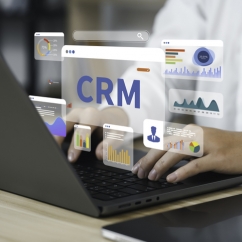Sales Strategy
Top Strategies for Mastering Retail Marketing Automation July 10, 2024 (0 comments)

Wilmington, DE--Achieving success in retail involves offering exceptional products and providing a seamless and personalized shopping experience. Retail marketing automation is a powerful tool that helps businesses engage customers effectively, saving time and resources.
[Image via istockphoto.com]
Understanding Retail Marketing Automation
What is Retail Marketing Automation?
An article in EngageBay talks about retail marketing automation, which involves using tools and technologies to streamline and automate marketing tasks and processes. These include campaign management, personalized content delivery, and customer engagement.
Automation lets retailers personalize their marketing efforts and enhance the shopping experience, increasing customer satisfaction and loyalty.
Market Growth
The retail marketing automation market is growing rapidly. It is valued at $12.2 billion and expected to reach $33 billion by 2030, notes the article, highlighting a report by Statista.
Key Roles and Examples
Seamless Multichannel Engagement
Today's consumers interact with brands across multiple channels. Retail marketing automation ensures a consistent and engaging presence across websites, social media, and mobile apps. The article gives the example of Barista, which uses its mobile app to send personalized offers based on customer location and purchase history, driving in-store visits.
Personalized Customer Experiences
According to the article, retail marketing automation allows retailers to analyze customer behavior and preferences to tailor marketing messages and product recommendations. Amazon's recommendation engine, which suggests products based on browsing and purchase history, exemplifies this approach, driving higher conversion rates and customer loyalty.
Customer Lifecycle Nurturing
Automation enables businesses to nurture customers throughout their journey, from initial interaction to post-purchase. Platforms can automate lead nurturing processes based on user actions on websites or apps.
Getting Started with Retail Marketing Automation
Step #1: Define Objectives
Start by defining clear objectives for your marketing automation. Determine specific goals such as lead generation, increasing sales, or reducing cart abandonment rates. Identify your target audience and preferred communication channels. Establish metrics to measure success, such as revenue growth and conversion rates.
Step #2: Choose the Right Tools
Select appropriate marketing automation tools tailored to your business needs. Per the article, essential tools include:
- Customer Relationship Management (CRM): Centralizes customer data for targeted campaigns.
- Email and SMS Marketing: Streamlines personalized email and SMS campaigns.
- eCommerce Platforms: Automates order processing and cart recovery.
- Landing Pages and Web Forms: Facilitates lead generation and data collection.
Step #3: Build Your Customer Database
Collect and segment customer data based on demographics, purchase history, and engagement levels. This enables personalized messaging and effective campaign targeting.
Step #4: Develop Automated Workflows
Create predefined workflows that trigger actions based on customer behavior. Examples include welcome emails for new sign-ups and abandoned cart recovery emails.
Step #5: Monitor and Optimize
Continuously monitor and optimize your automation strategy. Analyze performance data, conduct A/B tests, and adjust your campaigns based on customer feedback and engagement metrics.
Benefits of Retail Marketing Automation
The article notes the below benefits of automating retail marketing.
Improved ROI
The article notes that retail marketing automation enhances campaign ROI by automating repetitive tasks and delivering personalized messages, reducing marketing costs and increasing effectiveness. It allows employees to focus on strategic planning, ensuring higher value and revenue from marketing efforts.
Increased Customer Engagement and Retention
Automated workflows enable timely and relevant communication, keeping customers engaged throughout their buying journey. Personalized messages and recommendations foster repeat purchases and long-term loyalty.
Access to Data-Driven Insights
Automation provides valuable insights into customer behavior and campaign performance, helping refine strategies and improve customer engagement.
Avoiding Common Pitfalls
Clear Objectives
Ensure your automation efforts align with business objectives. Avoid automating without a clear strategy to measure success.
Maintaining Human Touch
Balance automation with human interactions to avoid alienating customers. Ensure personalized and relevant content to maintain engagement.
Data Management
Regularly clean and update customer data to maintain accuracy. Poor data management can lead to ineffective automation.
Testing and Optimization
Test and optimize your automated campaigns regularly. Use A/B testing and performance data analysis to continuously improve your strategy.
Learn more in the article on EngageBay.






